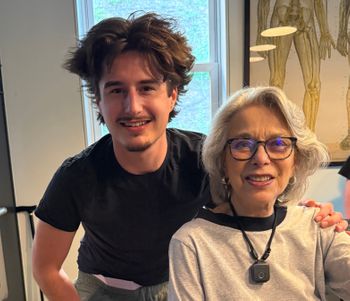Accident in the Jungle

Cas and grandmother, Karla Scherer
Casiel ‘Cas’ Thomas doesn’t remember the moment of the crash or getting thrown out of the vehicle. Here’s what he does remember: Driving his mom’s ATV late at night down a quiet two-lane road through the jungle. It was pitch dark—no streetlights or guardrails, typical for Costa Rica’s Guanacaste Province. The sounds of the jungle at night were familiar to Cas, who has been living there on and off for the last three years. Cas was alone on the road and had not seen any other vehicles. Suddenly, the beam from the ATV’s head-lights lit up a sharp curve. Cas jerked the wheel too sharply. He tried to correct, but the tire caught the edge of the asphalt and the vehicle flipped, launching Cas through the air into the jungle overgrowth.
The next clear memory he has is being helped onto the back of a stranger’s motorcycle. “What are the odds someone would be out there at that moment?” he says. “I will always think of him as my guardian angel.”
Shock and Pain
At home, Cas woke up his younger siblings first, nervous about getting in trouble with his mom for the damage to the ATV. Allison Scherer took one look at her son’s face and knew he was in shock. “I told him to sit down and instructed his brother and sister not to let him move,” she says. She got dressed and drove as fast as she dared to the nearest medical clinic. “By the time the X-ray technician came in, the shock had worn off and Cas was obviously in tremendous pain,” she recalls.
The X-rays revealed four fractured vertebra in Cas’s neck and back. He was strapped to a stretcher, loaded into an ambulance, and taken to a private hospital in the nearest big city, Liberia. There, a neurologist told Cas and Allison they would need to do surgery and put pins and screws into the spine.
Through friends, Allison got in touch with the top two neurosurgeons in Costa Rica’s capital city, San Jose, to see if they could operate on Cas. “They told me it would be too risky to airlift him not knowing the full extent of damage to his spine and that it would be better for us to stay put and have the surgery done there.” A day or two later Cas went in for what was supposed to be a three-hour surgery, but took five. “They found a hematoma on his spinal column, so it’s fortunate we didn’t move him!” says Allison.
Getting Better… Sort Of
As soon as Cas felt good enough to travel, the family went to Chicago where Allison’s mother, Karla Scherer, lives, and Allison took Cas to a hospital there for follow-up care. At first all seemed well. Cas was in pain, but he was told that’s a normal part of recovery. So he tried to make the best of it, did physical therapy, and was glad to have the ordeal behind him. But within 6–7 months after the surgery, he started feeling a different kind of pain. “I could feel pressure on different parts of my spine,” he says. “I kept telling people it felt like my screws were hurting.” He had also developed significant kyphosis, a rounding of the spine. Another round of X-rays showed Cas was right: the screws had come loose. A second surgery was recommended, this one longer and more complex. The surgeon wanted to do two procedures: first, remove the existing hardware and put in longer pins and screws, as well as additional hardware one vertebra higher and lower than what had been done before. Second, they would make an incision on Cas’s left side to access the vertebrae that had been crushed, cut out the broken pieces, put in a titanium collar around the spinal cord, and graft pieces of bone around the collar.
Calling for Backup
For such a major surgery Allison wanted to be absolutely certain Cas was getting the best care. For years she has heard her mom Karla talk about Healthnetwork Foundation, and she’d always known in the back of her mind it was available to her if needed. This, she knew, was the moment.
“I’m a journalist and a documentary filmmaker, and I’m a really good researcher—but you can’t research something like this enough!” says Allison. “Knowing that Healthnetwork was in my corner helping me research this was very comforting.”
After investigating a number of options and seeking out multiple second opinions, Allison chose to go with Healthnetwork’s number one recommendation: Dr. Russel Huang, an orthopedic surgeon and the director of the spine surgery clinic at Hospital for Special Surgery in New York.
“Meeting with Dr. Huang was a night-and-day difference from other hospitals and surgeons we’d met with. He really seemed to understand the emotional state we were in. He was never in any rush. He answered every single question and explained things in great detail. Cas’s surgery took 11 hours and he made sure I was kept updated all along the way. He even called me himself midway through to give me a report.”
It’s been almost a year since the second surgery, and Cas is hopeful. “I have no pain and I feel like I’m getting better and stronger every day. It’s so different from the last time,” he says. “I’ll be forever grateful to Dr. Huang. He still calls me to check up on me—and to Kim and Healthnetwork. I wouldn’t be where I am today without them.”
